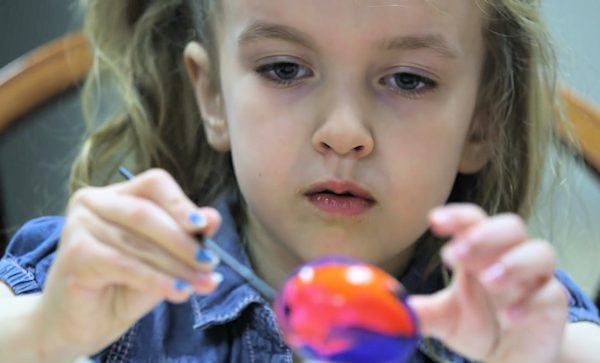United Methodist Communications shares a delightful video on sharing Easter joy with children.
UMCOM — Experts from the age of five to ten, as well as the Rev. MaryJane Pierce Norton, talk about the traditions of the Easter egg — from hunting eggs, to coloring them, to the egg as a symbol of new life. The egg became associated with Easter somewhere near the 400s and was often a food that was given up at Lent. According to Norton, “In some of the early church traditions, people brought their eggs to the church to be blessed before they ate them, as the first joyful food of Easter.”
Please also enjoy “Outtakes” and other cute stuff we couldn’t fit into the video.
Video Script:
Finn and Fiona: When we find Easter eggs and eat the candy inside them.
Katie: There’s a treat inside usually.
(Interviewer’s voice) What’s inside them?
Geoffrey: Candy. And sometimes if I get lucky, money.
Full Screen Graphic: The Importance of the Egg: Children and Easter
MaryJane Pierce Norton, Discipleship Ministries: The egg was used in a lot of the early civilizations to talk about even the forming of the world. It was adopted by the Christian faith so that it became the symbol then of the new life that we received in Christ.
(Jake during Easter egg hunt) Where’d it go?
Norton: The Easter egg hunt probably started partly because it was a fun thing for children to do.
(Cadence laughs during egg hunt)
Norton: The eggs were more likely to be connected to what they really are, which is food.
Chanz: And then when we was done with them, we ate them.
Norton: Children would take their hats or their bonnets or even a cardboard box and decorate it and would put it outside to make a nest for the Easter bunny to come and lay the eggs.
Norton: With so many Easter traditions, we look at them from the eyes of faith and we say, ‘Wow, there’s something about going to hunt the eggs just as we might go to hunt for Jesus in the tomb.’
Geoffrey: Except the Easter eggs are more than one, so it would be like looking for multiple Jesuses.
Norton: And when we find them it’s that joy that the women had when they reached the tomb first and found that Jesus was no longer there.
(Jake during Easter egg hunt) Get back there little egg!
FULL SCREEN: How do you color Easter eggs?
Norton: With the painting of the egg, one of the earlier traditions says that they were first painted red because red is a color of joy.
Finn and Fiona: But when they’re all different colors it’s kind of easy to find them.
Norton: But from the red we then morphed into all sorts of other colors…
Finn and Fiona: Purple, (purple). Red, (red). Yellow, (yellow).
Norton: …and other ways to say “this is a joyful thing.”
Finn and Fiona: Blue, (blue). Green (green).
Norton: Eggs were also used to greet one another on Easter. You took an egg and when you saw another person you would basically click eggs to say, “Christ is alive. Christ is alive indeed.”
Geoffrey: See they like come in different colors. You open ‘em from the bottom and then you put…no – you take the stuff out. And then you put confetti in and then you close it with like paper. And then you can crack ‘em on somebody’s head. (You can what?!?) You can crack ‘em on somebody’s head.
(Children crack confetti eggs)
FULL SCREEN: What is the story of Easter?
Chanz: Easter is when Jesus rose from the dead.
Katie: Jesus died on the cross for us.
Norton: It’s not an easy story for adults. And thus it makes it not an easy story for children. They don’t have to have the dramatic aspects of it to appreciate the fact that Jesus died, Jesus was buried, Jesus arose and lives again.
Cadence: But he wasn’t there. It’s magic.
Chanz: Every time I look outside the sun is shining real bright, I think it’s Easter because that’s always the day when the sun is shining.
Norton: When we use the eggs we really do want to remind children of what the egg is, which is life-giving. But we also have the fun of that egg — the beauty of it.
That new life that you don’t expect within a shell, just like the tomb was the shell around Jesus’ body that cracked open with new life.
FULL SCREEN: The End
Finn and Fiona: Happy Easter.
Cadence: Happy Easter. (Thank you, you did a very good job!)
We opted to leave out part of the explanation about the tradition of coloring eggs red at Easter because the video is for children as well as adults, but wanted to include it here. “It’s also connected to the fact that blood is red and that we have Jesus as our sacrifice at Easter — that his blood was spilled for us so that we would have eternal life just as he had eternal life,” notes Norton.
Mexican confetti eggs, called cascarones, which may have originally come from China, are common throughout Latin America. Used mostly in Mexico during Carnival, they became associated with Easter especially in U.S. and Mexico border towns. Cáscara means “eggshell” in Spanish and having one cracked on your head is good luck.
This video was produced in 2014 by United Methodist Communications.
Last Updated on October 23, 2023

